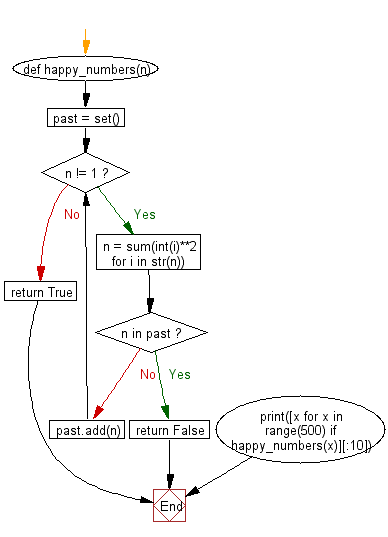Python: Find and print the first 10 happy numbers
First 10 Happy Numbers
From Wikipedia,
A happy number is defined by the following process:
Starting with any positive integer, replace the number by the sum of the squares of its digits, and repeat the process until the number equals 1 (where it will stay), or it loops endlessly in a cycle which does not include 1. Those numbers for which this process ends in 1 are happy numbers, while those that do not end in 1 are unhappy numbers.
Write a Python program to find and print the first 10 happy numbers.
Sample Solution:
Python Code:
# Function to check if a number is a Happy Number
def happy_numbers(n):
past = set() # Set to store previously encountered numbers during the process
while n != 1: # Continue the process until the number becomes 1 (a Happy Number) or a cycle is detected
n = sum(int(i) ** 2 for i in str(n)) # Calculate the sum of squares of each digit in the number
if n in past: # If the current number has been encountered before, it forms a cycle
return False # The number is not a Happy Number
past.add(n) # Add the current number to the set of past numbers
return True # If the process reaches 1, the number is a Happy Number
# Print the first 10 Happy Numbers less than 500
print([x for x in range(500) if happy_numbers(x)][:10])
Sample Output:
[1, 7, 10, 13, 19, 23, 28, 31, 32, 44]
Explanation:
Here is a breakdown of the above Python code:
- Define a function named "happy_numbers()" that takes a number 'n' as input.
- Initialize a set called 'past' to keep track of previously encountered numbers during the process.
- Use a while loop to continue the process until the number becomes 1 (a Happy Number) or a cycle is detected.
- Inside the loop, calculate the sum of the squares of each digit in the current number.
- Check if the current number has been encountered before. If yes, it forms a cycle, and the number is not a Happy Number.
- Add the current number to the set of past numbers.
- Return 'True' if the process reaches 1, indicating that the number is a Happy Number.
- Use a list comprehension to generate the first 10 Happy Numbers less than 500 and print the result.
Visual Presentation:
Flowchart:

For more Practice: Solve these Related Problems:
- Write a Python program to generate the first 10 happy numbers by iterating over positive integers.
- Write a Python program to collect and display the first 10 numbers that satisfy the happy number condition using a helper function.
- Write a Python program to compute happy numbers until 10 such numbers are found, using optimized cycle detection.
- Write a Python program to iterate over natural numbers and print the first 10 happy numbers as they are discovered.
Go to:
Previous: Write a Write a Python program to check whether a number is "happy" or not.
Next: Write a Python program to count the number of prime numbers less than a given non-negative number.
Python Code Editor:
Have another way to solve this solution? Contribute your code (and comments) through Disqus.
What is the difficulty level of this exercise?
Test your Programming skills with w3resource's quiz.
